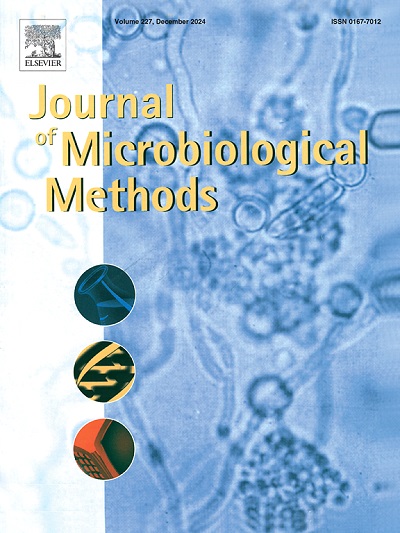Mycobacterium tuberculosis complex sample processing by mechanical lysis, an essential step for reliable whole genome sequencing
IF 1.9
4区 生物学
Q4 BIOCHEMICAL RESEARCH METHODS
引用次数: 0
Abstract
Mycobacterium tuberculosis complex (MTBC) whole genome sequencing (WGS) turnaround time and WGS success rates are highly influenced by DNA extraction protocols even from cultures. Efficient mycobacterial lysis is crucial for obtaining sufficient DNA from cultures to facilitate reliable genomic drug susceptibility prediction and accurate genotyping with WGS. We compared four DNA extraction protocols from BD BACTEC™ Mycobacterial Growth Indicator Tubes (MGIT) for WGS with a focus on the lysis step: protocol A) column-based protocol without mechanical lysis; protocol B) an adapted protocol including a bead beating step; protocol C) DNA extraction from primary received cultures using bead beating: and protocol D) DNA extraction from pre MGIT-positive (enriched) cultures. Protocol B increased DNA yield approximately 60-fold, and significantly improved the sequencing success rate. The increased yield also allowed DNA extraction from primary cultures with high success rates (protocol C). Additionally, by using pre-positive enriched MGIT cultures, we demonstrated that bead beating opens the possibility of reliable WGS up to five days before a MGIT tube would be flagged positive (protocol D). The most optimal bead beating-based DNA extraction was also evaluated for Nanopore sequencing. Shortening bead beating duration to 15 s resulted in longer read lengths (N50 from 1.4 kb to 2.6 kb) while still providing efficient lysis. Furthermore, AmpureXP bead beating-based DNA capture / purification proved to be as efficient as Qiagen column-based DNA extraction, further simplifying and shortening the DNA extraction protocol. Adding a mechanical lysis step to our routine MTBC DNA extraction protocol has allowed us to reduce the turnaround time while maintaining DNA quality sequencing success rates.
通过机械裂解处理结核分枝杆菌复合样本,这是可靠的全基因组测序的必要步骤
结核分枝杆菌(MTBC)全基因组测序(WGS)的周转时间和 WGS 成功率受 DNA 提取方案的影响很大,即使是从培养物中提取也是如此。高效的分枝杆菌裂解对于从培养物中获得足够的 DNA 至关重要,这样才能通过 WGS 进行可靠的基因组药物敏感性预测和准确的基因分型。我们比较了用于 WGS 的 BD BACTEC™ 分枝杆菌生长指示管(MGIT)中的四种 DNA 提取方案,重点是裂解步骤:方案 A:基于柱的方案,无机械裂解;方案 B:经过调整的方案,包括打珠步骤;方案 C:使用打珠从原始接收培养物中提取 DNA;以及方案 D:从 MGIT 阳性(富集)前培养物中提取 DNA。B 方案将 DNA 产量提高了约 60 倍,并显著提高了测序成功率。产量的提高也使得从原代培养物中提取 DNA 的成功率更高(方案 C)。此外,通过使用阳性前富集的 MGIT 培养物,我们证明了在 MGIT 管被标记为阳性前五天内,打珠为可靠的 WGS 提供了可能性(方案 D)。我们还评估了用于 Nanopore 测序的最佳微珠敲打 DNA 提取方法。将微珠跳动持续时间缩短至 15 秒可获得更长的读取长度(N50 从 1.4 kb 到 2.6 kb),同时还能提供高效的裂解。此外,事实证明,基于 AmpureXP 微珠跳动技术的 DNA 捕获/纯化与基于 Qiagen 柱的 DNA 提取同样高效,进一步简化和缩短了 DNA 提取方案。在我们的常规 MTBC DNA 提取方案中加入机械裂解步骤,使我们能够缩短周转时间,同时保持 DNA 质量测序的成功率。
本文章由计算机程序翻译,如有差异,请以英文原文为准。
求助全文
约1分钟内获得全文
求助全文
来源期刊

Journal of microbiological methods
生物-生化研究方法
CiteScore
4.30
自引率
4.50%
发文量
151
审稿时长
29 days
期刊介绍:
The Journal of Microbiological Methods publishes scholarly and original articles, notes and review articles. These articles must include novel and/or state-of-the-art methods, or significant improvements to existing methods. Novel and innovative applications of current methods that are validated and useful will also be published. JMM strives for scholarship, innovation and excellence. This demands scientific rigour, the best available methods and technologies, correctly replicated experiments/tests, the inclusion of proper controls, calibrations, and the correct statistical analysis. The presentation of the data must support the interpretation of the method/approach.
All aspects of microbiology are covered, except virology. These include agricultural microbiology, applied and environmental microbiology, bioassays, bioinformatics, biotechnology, biochemical microbiology, clinical microbiology, diagnostics, food monitoring and quality control microbiology, microbial genetics and genomics, geomicrobiology, microbiome methods regardless of habitat, high through-put sequencing methods and analysis, microbial pathogenesis and host responses, metabolomics, metagenomics, metaproteomics, microbial ecology and diversity, microbial physiology, microbial ultra-structure, microscopic and imaging methods, molecular microbiology, mycology, novel mathematical microbiology and modelling, parasitology, plant-microbe interactions, protein markers/profiles, proteomics, pyrosequencing, public health microbiology, radioisotopes applied to microbiology, robotics applied to microbiological methods,rumen microbiology, microbiological methods for space missions and extreme environments, sampling methods and samplers, soil and sediment microbiology, transcriptomics, veterinary microbiology, sero-diagnostics and typing/identification.
 求助内容:
求助内容: 应助结果提醒方式:
应助结果提醒方式:


